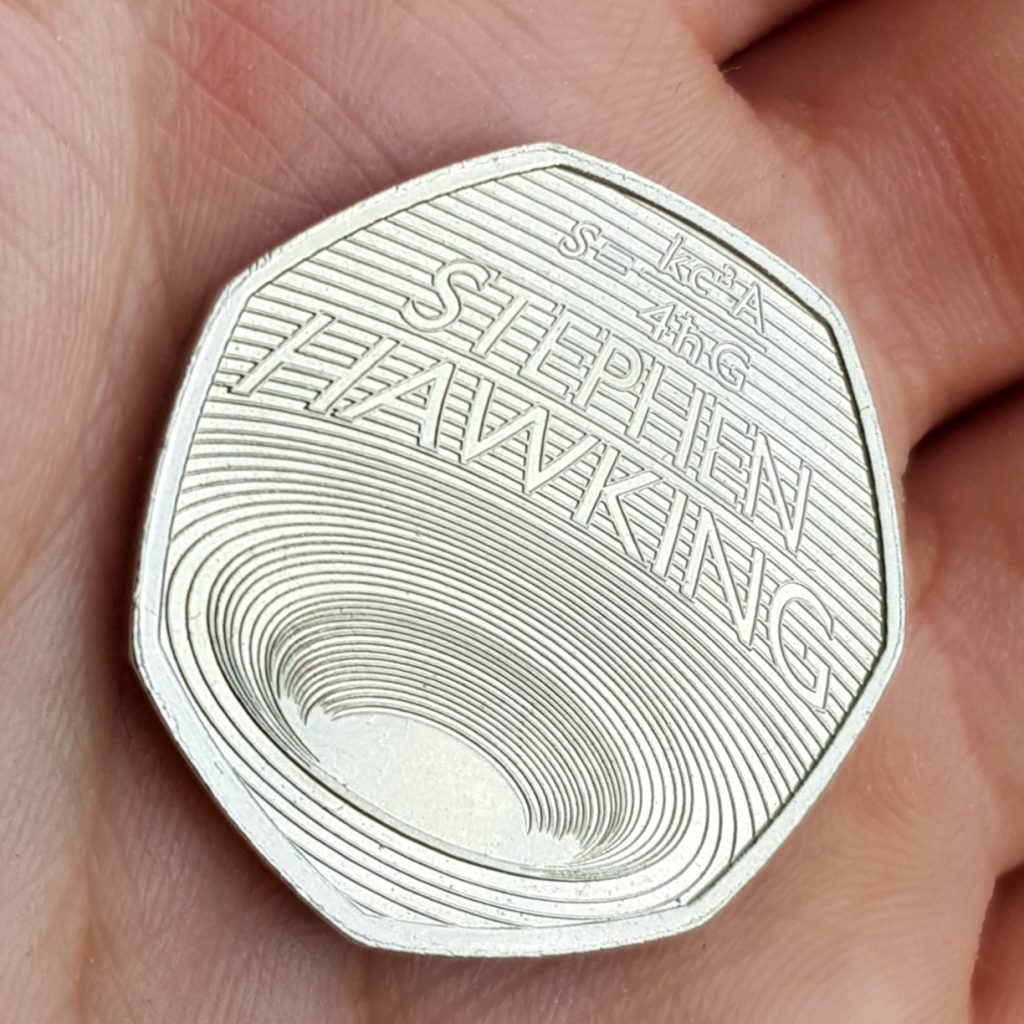Uncategorised
Brand new Alan Turing 50p set to rival the demand of Stephen Hawking 50p!
Founder of modern computer science, English mathematician and philosopher, Alan Turing is famed for his leading role in breaking Nazi ciphers during the Second World War by decoding the Enigma Machine.
His contributions to the war effort, along with his concepts in theoretical computer science and artificial intelligence make him one of the most influential British figures of the 20th century.
In 2022, to celebrate his life and achievements, The Royal Mint issued a brand new 50p coin, designed by Matt Dent and Christian Davies.
Tucked behind a representation of machine cogs, in a touching nod to Turing’s code-breaking, Bombe, enigma-inspired code features as an inscription.
But, this coin’s design also features several secret features, which are SURE to grab the attention of the most serious coin collectors. Can you decipher them?
GEARS GRIN THAN

Can you spot the words ‘GEARS GRIN THAN’ on the design of this coin?
When these words are entered into the ‘What 3 Words‘ navigation database, it shows a location for the University of Cambridge, where Turing studied mathematics!
ONLY A FORETASTE OF WHAT’S TO COME
The next hidden message is one of my favourite features of any UK coin.
Alan Turing’s famous quote ‘Only a foretaste of what is to come’ appears as an inscription.
This quote came from his reflections of his code-breaking machine, Bombe.

CD AND MD

And of course, the designers behind this fantastic design get an honorary feature, with Christian Davies and Matt Dent’s initials featuring as an inscription.
To secure this coin for your collection for just £4.99 (+p&p) in Brilliant Uncirculated quality, simply click here >>
Your coin will come protectively encapsulated in official Change Checker packaging, to preserve it for generations to come.
Wartime hero, Alan Turing

Credit: PhotoColour via Wikimedia Commons
Alan Turing is so famed for his efforts during the Second World War, that his life and achievements have been written into story books, and even portrayed on the big screen!
Both Turing and Stephen Hawking are famed for their technological advancements, having both been celebrated on TV and film. But now, they’ve now both been commemorated on a UK 50p!
The 2019 Stephen Hawking 50p saw huge worldwide interest and SELL OUTS at The Royal Mint within just hours of release!

Due to the popularity and fame of this British scientist, it was no surprise that the Stephen Hawking 50p was picked up in news articles across the globe, with Her Majesty Queen Elizabeth II even commenting that it was one of her favourite coin designs!
The best news, you can get your hands on the 2019 Stephen Hawking 50p in the Innovation in Science 50p Set. But, Change Checker has JUST 500 full sets available to own in Brilliant Uncirculated quality.

Alongside the SOLD-OUT Stephen Hawking 50p, in this set, you’ll also receive the other FIVE Innovation in Science 50p coins. Click here to secure yours whilst stock lasts >>
We fully expect demand for the new Alan Turing 50p to cause the same sort of rush as the Stephen Hawking 50p. If you don’t want to miss out on the 2022 UK Alan Turing 50p, like many did for the Stephen Hawking 50p, then be sure to secure yours here >>
Secure the 2022 UK Alan Turing 50p for your collection!

Don’t miss out the coin set to rival the Stephen Hawking 50p! Secure it for your collection in Brilliant Uncirculated quality for JUST £4.99 (+p&p) by clicking here >>
Your coin will come presented in official Change Checker packaging, preserved for generations to come.
Birmingham 2022 Commonwealth Games celebrated on new UK 50p coin!
Since 1930, the Commonwealth Games have brought nations together in a celebration of sport and human performance.
The Games have grown from just 11 countries and 400 athletes, to a global sensation featuring 6,600 sports men and women across 72 nations and territories.
This year, to celebrate the Birmingham 2022 Commonwealth Games, a brand new UK 50p has been released!
2022 UK Commonwealth Games 50p
Initially issued as part of The Royal Mint’s 2022 Annual Coin Set, this brand new 50p issue, designed by Natasha Preece, incorporates the unmistakable geometric patterns of Birmingham Library.
What’s more, this coin has been collaboratively developed with Birmingham 2022 and each home nation’s respective team!
To secure your 2022 UK Commonwealth Games 50p for JUST £4.99 (+p&p) simply click here >>
Your coin has been struck to a Brilliant Uncirculated quality and protectively encapsulated to preserve for generations to come.
With this high level of anticipation for the UK’s next sporting coin, this new Commonwealth Games 50p is expected to be incredibly sought-after among collectors…

Sporting coins are some of the most popular themes of UK coins, with previous coin issues seeing sell-outs and high demand…
2022 UK 150 Years of the FA Cup £2
In 2022, to celebrate a remarkable 150 years of the FA Cup, a brand new UK £2 coin was issued featuring the famed FA Cup Trophy.
This coin was so popular with collectors that the entire special edition range sold out within less than 24 hours at The Royal Mint!
Producing hometown heroes, as underdogs play alongside Premier League giants, these unforgettable moments unite football fans, making the FA Cup one of the greatest knockout tournaments in the world.
Sporting events such as these create huge fan-bases all across the world, each looking for a way to commemorate their favourite team or athlete’s successes.
Therefore, there’s no surprises sporting memorabilia is some of the most sought-after around the globe!
2021 UK Team GB 50p
This coin was initially issued as part of the 2020 Annual Coin Set but with the postponement of the Olympic Games to 2021, this 50p was never individually released in 2020.
This made this 50p one of most sought-after coins in recent years, with collectors having waited a whole year to get their hands on the individual issue.
Additionally, due to the postponement of both the games and the issue of this 50p, there are two versions of the coin – one with the obverse dated 2020 from the 2020 Annual Coin Set and one with the obverse dated 2021 from the year of individual release.
This makes the 2021 Team GB 50p one of only a small handful of UK 50ps to feature a dual-date – only adding to the collectability of the new coin!
2002 Commonwealth Games £2 coins
These four coins were issued in 2002 – again issued to celebrate the Commonwealth Games – this time held in Manchester.
Each has a different cameo, representing each of the four constituent parts of the United Kingdom.They are some of the scarcest £2 coins now in circulation, with the Northern Ireland design having a mintage of JUST 485,500!
The other coin designs have the following mintage figures:
- 2002 Commonwealth Games Wales £2: 588,500
- 2002 Commonwealth Games England £2: 650,500
- 2002 Commonwealth Games Scotland £2: 771,750
Find out more about these coins here >>
Sporting themed coins are some of the most sought-after issues a collector can get their hands on.
With the issue of the brand new 2022 UK Commonwealth Games 50p being the UK’s very latest sporting coin, demand is sure to be high.
Will you be securing this coin for your collection?
The 2022 UK Commonwealth Games 50p

Secure your 2022 UK Commonwealth Games 50p for JUST £4.99 (+p&p) by clicking here >>
Your coin has been struck to a Brilliant Uncirculated quality and protectively encapsulated to preserve for generations to come.
25 Years of the Bi-Metallic £2! Vote for your favourite design…
After a review of the United Kingdom coinage in 1994, it emerged that there was a requirement for a £2 coin to enter general circulation.
After extensive consultation, it was decided this would be a bi-colour coin, making it easily distinguishable from the other coins in circulation.
Originally, the intention was to issue the £2 coin in November 1997. However, concerns emerged from the vending industry over their size. The £2 coin was eventually launched on 15 June 1998, with millions of the coin released into circulation.
Since then we’ve seen over 35 different designs enter circulation!
And in 2022, the bi-metallic £2 coin celebrates its 25th birthday!
£2 coin vote – winning design revealed!
We asked you to vote for your favourite bi-metallic £2 coin design and the results are in!

Our winning coin design is the Great Fire of London £2, taking an impressive 17% of all votes! This coin was issued in 2016 to mark the 350th anniversary of one of the most well-known disasters to hit London.
However, three years after this coin was issued into circulation, it was revealed that its mintage figure was mistakenly listed and the coin is in fact rarer than once thought…
The previous figure of 5,135,000 meant this coin was fairly common but the updated figure of 1,625,000, makes this coin one of the rarest £2 coins in circulation!
Did your favourite coin design make the top 5? Let us know in the comments below!







